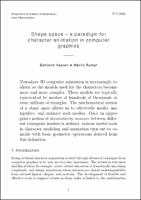| dc.contributor.author | Heeren, Behrend | |
| dc.contributor.author | Rumpf, Martin | |
| dc.contributor.editor | Skuppin, Lara | |
| dc.contributor.editor | Munday, Sara | |
| dc.contributor.editor | Jahns, Sophia | |
| dc.date.accessioned | 2020-10-07T09:00:13Z | |
| dc.date.available | 2020-10-07T09:00:13Z | |
| dc.date.issued | 2020-10-07 | |
| dc.identifier.uri | http://publications.mfo.de/handle/mfo/3798 | |
| dc.description.abstract | Nowadays 3D computer animation is increasingly realistic
as the models used for the characters become
more and more complex. These models are typically
represented by meshes of hundreds of thousands or
even millions of triangles. The mathematical notion
of a shape space allows us to effectively model, manipulate,
and animate such meshes. Once an appropriate
notion of dissimilarity measure between different
triangular meshes is defined, various useful tools
in character modeling and animation turn out to coincide
with basic geometric operations derived from
this definition. | en_US |
| dc.language.iso | en | en_US |
| dc.publisher | Mathematisches Forschungsinstitut Oberwolfach | en_US |
| dc.relation.ispartofseries | Snapshots of modern mathematics from Oberwolfach;2020,07 | |
| dc.rights | Attribution-ShareAlike 4.0 International | * |
| dc.rights.uri | http://creativecommons.org/licenses/by-sa/4.0/ | * |
| dc.title | Shape space – a paradigm for character animation in computer graphics | en_US |
| dc.type | Article | en_US |
| dc.identifier.doi | 10.14760/SNAP-2020-007-EN | |
| local.series.id | SNAP-2020-007-EN | en_US |
| local.subject.snapshot | Numerics and Scientific Computing | en_US |
| dc.identifier.urn | urn:nbn:de:101:1-2020100714540792661339 | |
| dc.identifier.ppn | 1735135968 | |


